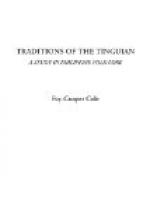Fables
The last division may be said to be made up of fables, for the story tellers without hesitation label them as fictions. The last of these appears to be only a worked over incident of myth 56, in which the big bird Banog carries the hero to its nest, from which he escapes by holding to the wings of the young birds. It is possible that more of these fables are likewise incidents in tales prevalent among the Tinguian, but not heard by the writer. Whether or no this be true, it is certain that most of these stories are well known to the Ilocano of the coast and the other Christianized natives throughout the archipelago. Comparison with the folk-lore from other regions shows that these stories are by no means confined to the Philippines. The chief incidents in the narrative of the turtle and the monkey have been recorded from the Kenyah of Borneo [70] and from the northern peninsula of Celebes [71]; the race between the shell and the carabao is told in British North Borneo [72] in regard to the plandok and crab, while it is known to European children as the race between the turtle and the hare. The threat of the mosquito in 84 is almost identical with that recorded by Evans in Borneo [73]; while many incidents in the fable of Dogidog [74] are found in the Iban story of Simpang Impang [75].
When comparing the Tinguian versions of these fables with those of the Ilocano, one is impressed with the fact that while the incidents upon which they are founded are often identical, the stories themselves have frequently been moulded and changed by the tellers, who have introduced bits of old customs and beliefs until they reflect, in a way, the prevalent ideas of the people. Thus in the story of the magic poncho [76], which is evidently of Spanish introduction, the owner is identified as the banbantay—a well-known minor spirit. Again, the first part of tale 85 is identical with that of the Ilocano, but ends with the parents of the groom preparing the things used in the pakalon—a very necessary part of the Tinguian marriage ceremony.
The footnotes have called attention to the many incidents which have their parallels in other districts. Reference to these shows that a large percentage are found in the islands toward the south. While recognizing that similarity of incidents does not necessarily mean identity of origin, we must still give full credit to the effects of borrowing, even over great distances. The easy communication along the coast during the past four hundred years and the contact with Spanish and Christianized officials and traders will readily explain the likeness of the tales in Division III to those held in distant islands, or even in Europe, but, as just noted, these are now undergoing change. Doubtless a similar inflow had been taking place, although at a slower rate, long before the Spaniards reached the Islands, and Tinguian mythology has grown up as the result of blending of native tales with those of other areas, the whole being worked over and reshaped until it fitted the social setting.




